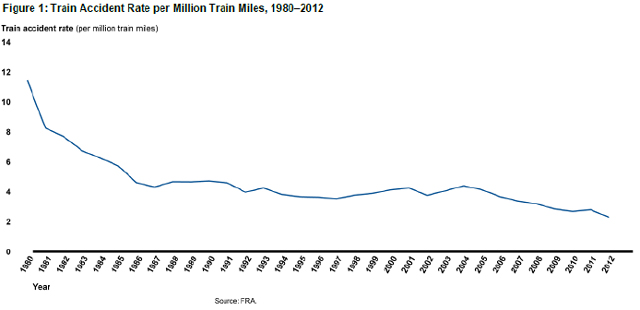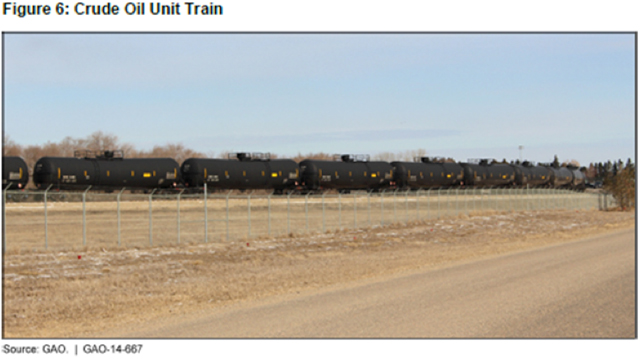U.S. Railroads: On the Right Track?
 (Excerpted from GAO-14-85)
(Excerpted from GAO-14-85)
- Using new safety technologies. FRA is implementing positive train control, a communications-based system designed to prevent certain types of rail accidents—such as train-to-train collisions—that are caused by human factors. However, the timeline has been delayed because the system’s components are in various stages of development. Installing components requires multiple phases of testing, which can take even longer with limited staff resources.
- Managing risks of shipping more hazardous materials. For example, the majority of crude oil transported by rail is shipped via “unit trains.” These may consist of 80 to 120 tank cars as shown below, each carrying about 30,000 gallons of oil. When shipping hazardous materials, the risk of any related accident, like recent derailments in West Virginia and Illinois, is more severe
- Employing sufficient numbers of inspectors. FRA expects 30 percent of its current and future staff to be eligible for retirement in the next 5 years.
 (Excerpted from GAO-14-667)
(Excerpted from GAO-14-667)
- Be the first U.S. rail line designed to operate at speeds up to 220 miles per hour, and
- Cost an estimated $68.4 billion, potentially making it the nation’s most expensive transportation project.
 (Excerpted from GAO-13-304)
(Excerpted from GAO-13-304)
- Questions on the content of this post? Contact Susan Fleming at flemings@gao.gov.
- Comments on GAO’s WatchBlog? Contact blog@gao.gov.

GAO's mission is to provide Congress with fact-based, nonpartisan information that can help improve federal government performance and ensure accountability for the benefit of the American people. GAO launched its WatchBlog in January, 2014, as part of its continuing effort to reach its audiences—Congress and the American people—where they are currently looking for information.
The blog format allows GAO to provide a little more context about its work than it can offer on its other social media platforms. Posts will tie GAO work to current events and the news; show how GAO’s work is affecting agencies or legislation; highlight reports, testimonies, and issue areas where GAO does work; and provide information about GAO itself, among other things.
Please send any feedback on GAO's WatchBlog to blog@gao.gov.
